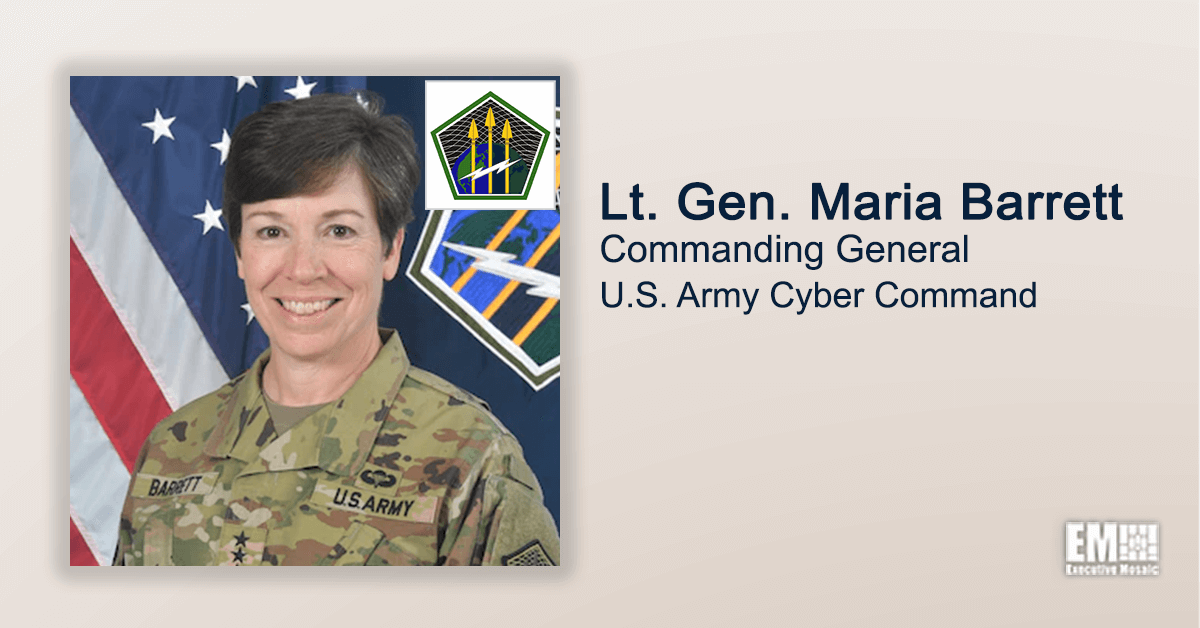U.S. Army Cyber Command is coordinating with the Army Training and Doctrine Command in the drafting process for a new publication focused on information advantage as a doctrinal concept. ADP 3-13 Information Operations, which is expected to be released soon, will be the key to achieving decision dominance, according to Lt. Gen. Maria Barrett, commanding general of ARCYBER.
Lt. Gen. Barrett, who took command of ARCYBER in May 2022, told virtual attendees at the GovCon Wire Events Second Annual Defense Cyber Forum that data, and the decision dominance it enables, is at the core of our competitive advantage as a nation.
“When ADP 3-13 comes out, what you’ll be able to see is that information advantage is a condition where the force holds the initiative,” said Barrett. “The critical tasks are seeing yourself, being able to see the adversary and understanding the operational environment while denying the same to your adversary.”
These capabilities, she explained, will help enable the Army and the joint force to understand, assess and act faster and more effectively than their adversaries.
The impending document is also anticipated to help the Army better understand what must be done with its network, which is “the weapons platform for our Army’s future,” Barrett said.
Harnessing this weapons platform for decision dominance hinges on four functions: acquire, transport, analyze and inform. Along the analysis function, ARCYBER leverages its Big Data Platform to ingest large data sets, conduct analytics and visualize results.
“The system allows critical decisions surrounding cyberspace operations to be made based on a richer and broader set of information,” said Barrett of the BDP. “This links the tactical side of the enterprise with its sensors to the strategic levels to aid in decision making.”
But this work can’t be done alone. Lt. Gen. Barrett underscored the importance of continual, robust partnerships in being able to harness the Army’s massive amounts of data. “I need continued partnership to work through the sensors, the understanding of the operational space and the developing of tools to translate that data into knowledge,” she urged.
“Working on this type of data isn’t just for when a crisis emerges,” Barrett commented. “But every day when our joint forces are in competition below the level of armed conflict.”
In addition to these efforts, ARCYBER is also prioritizing retention as it prepares to fight and win future conflicts in an evolving threat landscape. The Army Cyber Command has launched a new pilot, the Tailored Strategic Retention program, to not only help the service with retention and enhance total Army readiness, but also to provide service members with a pathway forward from active duty into either a reserve component or even the private sector.
Barrett describes the program as a unique opportunity for service members to explore both military and industry career trajectories while bettering the country’s workforce in the defense of our nation. “There are some 40 industry partners that we’re linking them up with across several sectors: finance, energy telecommunications and other technology sectors. So that’s talent that goes back into this audience’s workforce,” Barrett said to the forum’s federal contracting attendees.
These kinds of program investments are expected to strengthen the Army’s culture and better support its warfighters.
Through the new pilot, Barrett said, “We can show them that lifelong learning is a culture here. Continual investment in the workforce is part of our culture here.”

To learn more about the Army’s current and future priorities, technology investments and strategic initiatives, join the Potomac Officers Club for its 2022 7th Annual Army Summit on Aug. 24. Hon. Gabe Camarillo, under secretary and chief management officer of the Army, is scheduled to deliver an opening keynote address.
Register here to save your spot for this anticipated in-person summit!




